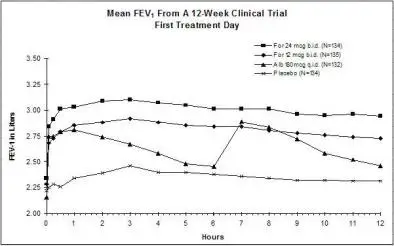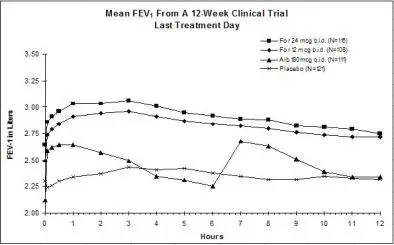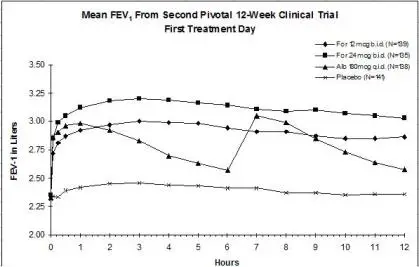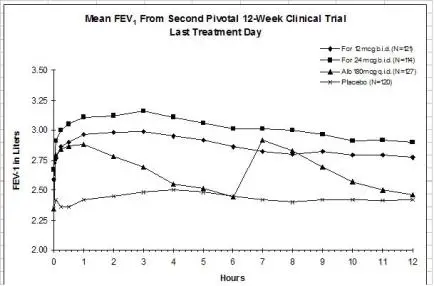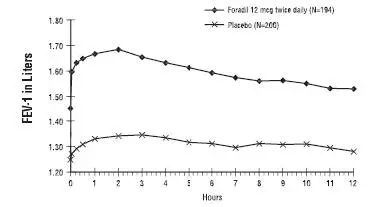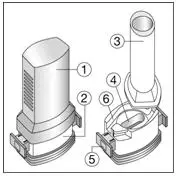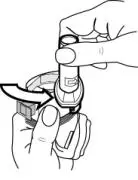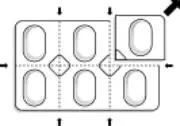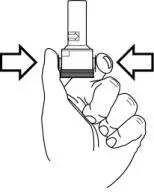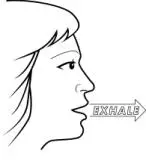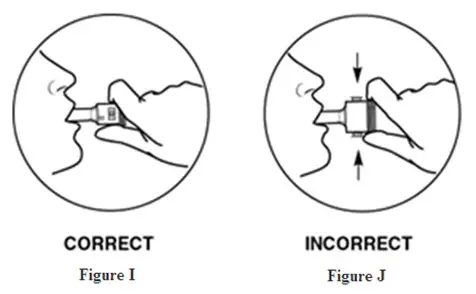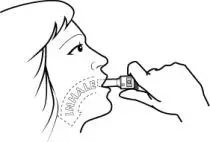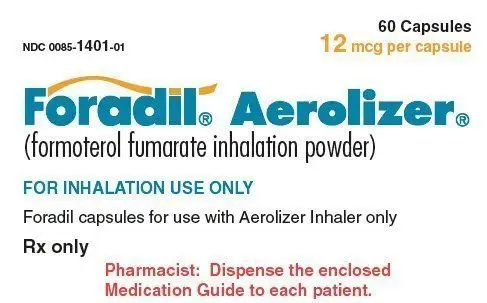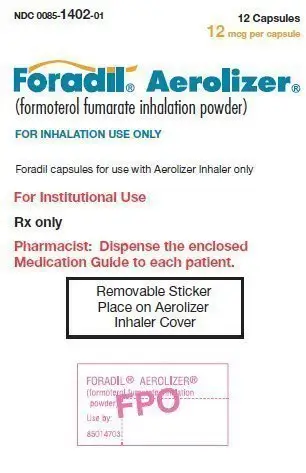Drug Detail:Foradil aerolizer (Formoterol (inhalation) [ for-moe-ter-all ])
Drug Class: Adrenergic bronchodilators
Highlights of Prescribing Information
FORADIL AEROLIZER (formoterol fumarate inhalation powder)
FOR ORAL INHALATION ONLY
Initial U.S. Approval: 2001
WARNING: ASTHMA-RELATED DEATH
See full prescribing information for complete boxed warning
-
Long-acting beta2-adrenergic agonists (LABA), such as formoterol the active ingredient in FORADIL, increase the risk of asthma-related death. A large placebo-controlled study with another LABA (salmeterol) showed an increase in asthma-related deaths in patients receiving salmeterol. This finding with salmeterol is considered a class effect of LABA, including formoterol. (5.1)
-
Prescribe FORADIL AEROLIZER only as additional therapy for patients with asthma who are currently taking but are inadequately controlled on a long-term asthma control medication, such as an inhaled corticosteroid. Once asthma control is achieved and maintained, assess the patient at regular intervals and step down therapy (e.g., discontinue FORADIL AEROLIZER) if possible without loss of asthma control and maintain the patient on a long-term asthma control medication, such as an inhaled corticosteroid. Do not use FORADIL AEROLIZER for patients whose asthma is adequately controlled on low- or medium-dose inhaled corticosteroids. (1.1, 5.1).
- Available data from controlled clinical trials suggest that LABA increase the risk of asthma-related hospitalization in pediatric and adolescent patients. (5.1)
Recent Major Changes
Warnings and Precautions, Coexisting Conditions (5.8) 09/2012
Indications and Usage for Foradil
FORADIL AEROLIZER is a LABA indicated for:
- Treatment of asthma in patients ≥5 years as an add-on to a long-term asthma control medication such as an inhaled corticosteroid. (1.1)
- Prevention of exercise-induced bronchospasm (EIB) in patients ≥5 years. (1.2)
- Maintenance treatment of bronchoconstriction in patients with chronic obstructive pulmonary disease (COPD). (1.3)
Important limitations of use:
- NOT indicated for the relief of acute bronchospasm. (1.1, 1.3)
Foradil Dosage and Administration
For oral inhalation only. DO NOT swallow Foradil capsule. Foradil capsule should be always used with Aerolizer inhaler ONLY.
- Treatment of asthma in patients ≥5 years: Inhalation of one capsule every 12 hours in addition to concomitant treatment with a long-term control medication such as an inhaled corticosteroid. (2.1)
- EIB: Inhalation of one capsule at least 15 minutes before exercise Additional doses should not be used for 12 hours. (2.2)
- Maintenance treatment of bronchoconstriction in patients with COPD: Inhalation of one capsule every 12 hours. (2.3)
Dosage Forms and Strengths
Foradil capsules for oral inhalation: 12 mcg formoterol fumarate powder, for use with Aerolizer inhaler. (3)
Contraindications
- Asthma: Without concomitant use of a long-term asthma control medication such as an inhaled corticosteroid. (4)
- Hypersensitivity to formoterol fumarate or any components of this product. (4)
Warnings and Precautions
- Asthma-related deaths and asthma-related hospitalizations: LABA increase the risk. Prescribe for asthma only as concomitant therapy with a long-term control medication such as an inhaled corticosteroid. (5.1)
- Deterioration of asthma and acute episodes: Do not initiate during acutely deteriorating asthma. Do not use to treat acute symptoms. (5.2)
- Corticosteroids: Not a substitute for corticosteroids. Corticosteroids should not be stopped or reduced when FORADIL AEROLIZER is initiated. (5.3)
- Use with additional long-acting beta2-agonist: Do not use in combination because of risk of overdose. (5.4)
- Paradoxical bronchospasm: Discontinue FORADIL AEROLIZER and institute alternative therapy if paradoxical bronchospasm occurs. (5.5)
- Patients with cardiovascular or central nervous system disorders: Use with caution because of beta-adrenergic stimulation. (5.6)
- Coexisting conditions: Use with caution in patients with convulsive disorders, thyrotoxicosis, diabetes mellitus, ketoacidosis, aneurysm, and pheochromocytoma. (5.8)
- Metabolic effects: Be alert to hypokalemia and hyperglycemia. (5.9)
Adverse Reactions/Side Effects
Most common adverse reactions (incidence ≥1% and more common than placebo) are:
- Asthma: viral infection, bronchitis, chest infection, dyspnea, chest pain, tremor, dizziness, insomnia, tonsillitis, rash, dysphonia, and serious asthma exacerbation. (6.1, 6.3)
- COPD: Upper respiratory tract infection, back pain, pharyngitis, chest pain, sinusitis, fever, leg cramps, muscle cramps, anxiety, pruritus, increased sputum, and dry mouth. (6.2)
To report SUSPECTED ADVERSE REACTIONS, contact Merck Sharp & Dohme Corporation, a subsidiary of Merck & Co., Inc. at 1-877-888-4231 or FDA at 1-800-FDA-1088 or www.fda.gov/medwatch.
Drug Interactions
- Adrenergic agents: Use with caution. Additional adrenergic drugs may potentiate sympathetic effects. (7.1)
- Xanthine derivatives, systemic corticosteroids, and non-potassium sparing diuretics: Use with caution. May potentiate hypokalemia or ECG changes. (7.2, 7.3)
- MAO inhibitors, tricyclic antidepressants, macrolides, and drugs that prolong QTc interval: Use with extreme caution. May potentiate effect on cardiovascular system. (7.4)
- Beta-blockers: Use with caution and only when medically necessary. May decrease effectiveness and produce severe bronchospasm. (7.5)
- Halogenated hydrocarbons: There is an elevated risk of arrhythmias in patients receiving concomitant anesthesia with halogenated hydrocarbons. (7.6)
See 17 for PATIENT COUNSELING INFORMATION and Medication Guide.
Revised: 11/2012
Related/similar drugs
Dupixent, Xolair, albuterol, montelukast, Symbicort, Singulair, Breo ElliptaFull Prescribing Information
1. Indications and Usage for Foradil
1.1 Treatment of Asthma
FORADIL AEROLIZER is indicated for the treatment of asthma and in the prevention of bronchospasm only as concomitant therapy with a long-term asthma control medication, such as an inhaled corticosteroid, in adults and children 5 years of age and older with reversible obstructive airways disease, including patients with symptoms of nocturnal asthma.
Long acting beta2-adrenergic agonists (LABA), such as formoterol, the active ingredient in FORADIL AEROLIZER, increase the risk of asthma-related death. Use of FORADIL AEROLIZER for the treatment of asthma without concomitant use of a long-term asthma control medication, such as an inhaled corticosteroid, is contraindicated. Use FORADIL AEROLIZER only as additional therapy for patients with asthma who are currently taking but are inadequately controlled on a long-term asthma control medication, such as an inhaled corticosteroid. Once asthma control is achieved and maintained, assess the patient at regular intervals and step down therapy (e.g., discontinue FORADIL AEROLIZER) if possible without loss of asthma control, and maintain the patient on a long-term asthma control medication, such as an inhaled corticosteroid. Do not use FORADIL AEROLIZER for patients whose asthma is adequately controlled on low or medium dose inhaled corticosteroids [see Contraindications (4) and Warnings and Precautions (5.1)].
Pediatric and Adolescent Patients
Available data from controlled clinical trials suggest that LABA increase the risk of asthma-related hospitalization in pediatric and adolescent patients. For pediatric and adolescent patients with asthma who require addition of a LABA to an inhaled corticosteroid, a fixed-dose combination product containing both an inhaled corticosteroid and LABA should ordinarily be used to ensure adherence with both drugs. In cases where use of a separate long-term asthma control medication (e.g., inhaled corticosteroid) and LABA is clinically indicated, appropriate steps must be taken to ensure adherence with both treatment components. If adherence cannot be assured, a fixed-dose combination product containing both an inhaled corticosteroid and LABA is recommended [see Warnings and Precautions (5.1)].
Important Limitation of Use
FORADIL AEROLIZER is NOT indicated for the relief of acute bronchospasm.
1.2 Prevention of Exercise-Induced Bronchospasm
FORADIL AEROLIZER is also indicated for the acute prevention of exercise-induced bronchospasm in adults and children 5 years of age and older, when administered on an occasional, as-needed basis. Use of FORADIL AEROLIZER as a single agent for the prevention of exercise-induced bronchospasm may be clinically indicated in patients who do not have persistent asthma. In patients with persistent asthma, use of FORADIL AEROLIZER for the prevention of exercise-induced bronchospasm may be clinically indicated, but the treatment of asthma should include a long-term asthma control medication, such as an inhaled corticosteroid.
1.3 Maintenance Treatment of Chronic Obstructive Pulmonary Disease
FORADIL AEROLIZER is indicated for the long-term, twice daily (morning and evening) administration in the maintenance treatment of bronchoconstriction in patients with Chronic Obstructive Pulmonary Disease including chronic bronchitis and emphysema.
Important Limitation of Use
FORADIL AEROLIZER is NOT indicated for the relief of acute bronchospasm.
2. Foradil Dosage and Administration
FORADIL capsules should be administered only by the oral inhalation route and only using the AEROLIZER Inhaler (see the accompanying Medication Guide). FORADIL capsules should not be swallowed. FORADIL capsules should always be stored in the blister, and only removed IMMEDIATELY BEFORE USE.
2.1 Asthma
Long-acting beta2-adrenergic agonists (LABA), such as formoterol, the active ingredient in FORADIL AEROLIZER, increase the risk of asthma-related death [see Warnings and Precautions (5.1)]. Because of this risk, use of FORADIL AEROLIZER for the treatment of asthma without concomitant use of a long-term asthma control medication, such as an inhaled corticosteroid, is contraindicated. Use FORADIL AEROLIZER only as additional therapy for patients with asthma who are currently taking but are inadequately controlled on a long-term asthma control medication, such as an inhaled corticosteroid. Once asthma control is achieved and maintained, assess the patient at regular intervals and step down therapy (e.g., discontinue FORADIL AEROLIZER) if possible without loss of asthma control, and maintain the patient on a long-term asthma control medication, such as an inhaled corticosteroid. Do not use FORADIL AEROLIZER for patients whose asthma is adequately controlled on low or medium dose inhaled corticosteroids.
Pediatric and Adolescent Patients
For adults and children 5 years of age and older, the usual dosage is the inhalation of the contents of one 12-mcg FORADIL capsule every 12 hours using the AEROLIZER Inhaler. The patient must not exhale into the device. The total daily dose of FORADIL should not exceed one capsule twice daily (24 mcg total daily dose). More frequent administration or administration of a larger number of inhalations is not recommended. If symptoms arise between doses, an inhaled short-acting beta2-agonist should be taken for immediate relief.
Available data from controlled clinical trials suggest that LABA increase the risk of asthma-related hospitalization in pediatric and adolescent patients. For patients with asthma less than 18 years of age who require addition of a LABA to an inhaled corticosteroid, a fixed-dose combination product containing both an inhaled corticosteroid and LABA should ordinarily be used to ensure adherence with both drugs. In cases where use of a separate long-term asthma control medication (e.g., inhaled corticosteroid) and LABA is clinically indicated, appropriate steps must be taken to ensure adherence with both treatment components. If adherence cannot be assured, a fixed-dose combination product containing both an inhaled corticosteroid and LABA is recommended.
2.2 Exercise-Induced Bronchospasm (EIB)
Use of FORADIL AEROLIZER as a single agent for the prevention of exercise induced bronchospasm may be clinically indicated in patients who do not have persistent asthma. In patients with persistent asthma, use of FORADIL AEROLIZER for the prevention of exercise induced bronchospasm may be clinically indicated, but the treatment of asthma should include a long-term asthma control medication, such as an inhaled corticosteroid. For adults and children 5 years of age or older, the usual dosage is the inhalation of the contents of one 12-mcg FORADIL capsule at least 15 minutes before exercise administered on an occasional as needed basis. When used intermittently as needed for prevention, protection may last up to 12 hours.
Additional doses of FORADIL AEROLIZER should not be used for 12 hours after the administration of this drug. Regular, twice-daily dosing has not been studied in preventing EIB. Patients who are receiving FORADIL AEROLIZER twice daily for treatment of their asthma should not use additional doses for prevention of EIB and may require a short-acting bronchodilator.
2.3 Chronic Obstructive Pulmonary Disease (COPD)
For maintenance treatment of bronchoconstriction in patients with COPD (including chronic bronchitis and emphysema) the usual dosage is the inhalation of the contents of one 12 mcg FORADIL capsule every 12 hours using the AEROLIZER inhaler.
A total daily dose of greater than 24 mcg is not recommended.
3. Dosage Forms and Strengths
FORADIL AEROLIZER consists of FORADIL capsules and an AEROLIZER inhaler. FORADIL capsules contain 12 mcg dry powder formulation of formoterol fumarate in a clear, hard gelatin capsule for inhalation use with the AEROLIZER inhaler only.
4. Contraindications
- Because of the risk of asthma-related death and hospitalization, use of FORADIL AEROLIZER for the treatment of asthma without concomitant use of a long-term asthma control medication, such as an inhaled corticosteroid, is contraindicated [see Warnings and Precautions (5.1)].
- FORADIL AEROLIZER is contraindicated as primary treatment of status asthmaticus or other acute episodes of asthma or COPD where intensive measures are required [see Warnings and Precautions (5.2)].
- FORADIL (formoterol fumarate) is contraindicated in patients with a history of hypersensitivity to formoterol fumarate or to any components of this product [see Warnings and Precautions (5.7)].
5. Warnings and Precautions
5.1 Asthma-Related Death
Long-acting beta2-adrenergic agonists, such as formoterol, the active ingredient in FORADIL AEROLIZER, increase the risk of asthma-related death. Currently available data are inadequate to determine whether concurrent use of inhaled corticosteroids or other long-term asthma control drugs mitigates the increased risk of asthma-related death from LABA.
Because of this risk, use of FORADIL AEROLIZER for the treatment of asthma without concomitant use of a long-term asthma control medication, such as an inhaled corticosteroid, is contraindicated. Once asthma control is achieved and maintained, assess the patient at regular intervals and step down therapy (e.g., discontinue FORADIL AEROLIZER) if possible without loss of asthma control, and maintain the patient on a long-term asthma control medication, such as an inhaled corticosteroid. Do not use FORADIL AEROLIZER for patients whose asthma is adequately controlled on low or medium dose inhaled corticosteroids.
Pediatric and Adolescent Patients
Available data from controlled clinical trials suggest that LABA increase the risk of asthma-related hospitalization in pediatric and adolescent patients. For pediatric and adolescent patients with asthma who require addition of a LABA to an inhaled corticosteroid, a fixed-dose combination product containing both an inhaled corticosteroid and LABA should ordinarily be considered to ensure adherence with both drugs. In cases where use of a separate long-term asthma control medication (e.g., inhaled corticosteroid) and LABA is clinically indicated, appropriate steps must be taken to ensure adherence with both treatment components. If adherence cannot be assured, a fixed-dose combination product containing both an inhaled corticosteroid and LABA is recommended.
A 28-week, placebo-controlled US study comparing the safety of salmeterol with placebo, each added to usual asthma therapy, showed an increase in asthma-related deaths in patients receiving salmeterol (13/13,176 in patients treated with salmeterol vs. 3/13,179 in patients treated with placebo; RR 4.37, 95% CI 1.25, 15.34). The increased risk of asthma-related death is considered a class effect of the long-acting beta2-adrenergic agonists, including formoterol. No study adequate to determine whether the rate of asthma-related death is increased with FORADIL AEROLIZER has been conducted.
Clinical studies with FORADIL AEROLIZER suggested a higher incidence of serious asthma exacerbations in patients who received FORADIL AEROLIZER than in those who received placebo [see Adverse Reactions (6.2, 6.3)]. The sizes of these studies were not adequate to precisely quantify the differences in serious asthma exacerbation rates between treatment groups.
The studies described above enrolled patients with asthma. No studies have been conducted that were adequate to determine whether the rate of death in patients with COPD is increased by long-acting beta2-adrenergic agonists.
5.2 Deterioration of Disease and Acute Episodes
FORADIL AEROLIZER should not be initiated in patients with significantly worsening, acutely deteriorating, or potentially life-threatening episodes of asthma or COPD. The use of FORADIL AEROLIZER in this setting is not appropriate [see Indications and Usage (1.1, 1.3)].
Asthma may deteriorate acutely over a period of hours or chronically over several days or longer. It is important to watch for signs of worsening asthma, such as increasing use of inhaled, short-acting beta2-adrenergic agonists or a significant decrease in peak expiratory flow (PEF) or lung function. Such findings require immediate evaluation. Patients should be advised to seek immediate attention should their condition deteriorate. Increasing the daily dosage of FORADIL AEROLIZER beyond the recommended dose in this situation is not appropriate. FORADIL AEROLIZER should not be used more frequently than twice daily (morning and evening) at the recommended dose.
FORADIL AEROLIZER should not be used to treat acute symptoms. FORADIL AEROLIZER has not been studied in the relief of acute symptoms and extra doses should not be used for that purpose. When prescribing FORADIL AEROLIZER, the physician should also provide the patient with an inhaled, short-acting beta2-agonist for treatment of symptoms that occur acutely, despite regular twice-daily (morning and evening) use of FORADIL AEROLIZER. Patients should also be cautioned that increasing inhaled beta2-agonist use is a signal of deteriorating asthma [see Information for Patients (17) and the accompanying Medication Guide.]
When beginning treatment with FORADIL AEROLIZER, patients who have been taking inhaled, short-acting beta2-agonists on a regular basis (e.g., four times a day) should be instructed to discontinue the regular use of these drugs and use them only for symptomatic relief of acute symptoms.
5.3 FORADIL AEROLIZER is not a substitute for corticosteroids
There are no data demonstrating that FORADIL has any clinical anti-inflammatory effect and therefore it cannot be expected to take the place of corticosteroids. Corticosteroids should not be stopped or reduced at the time FORADIL AEROLIZER is initiated. Patients who already require oral or inhaled corticosteroids for treatment of asthma should be continued on this type of treatment even if they feel better as a result of initiating FORADIL AEROLIZER. Any change in corticosteroid dosage, in particular a reduction, should be made ONLY after clinical evaluation [see Patient Counseling Information (17.2)].
5.4 Excessive Use and Use with Other Long-Acting Beta2-Agonists
FORADIL AEROLIZER should not be used more often or at doses higher than recommended, or in conjunction with other medications containing LABA, as an overdose may result. Patients using FORADIL AEROLIZER should not use an additional LABA (e.g., salmeterol xinafoate, arformoterol tartrate) for any reason. Fatalities have been reported in association with excessive use of inhaled sympathomimetic drugs in patients with asthma. The exact cause of death is unknown, but cardiac arrest following an unexpected development of a severe acute asthmatic crisis and subsequent hypoxia is suspected. In addition, data from clinical trials with FORADIL AEROLIZER suggest that the use of doses higher than recommended is associated with an increased risk of serious asthma exacerbations [see Adverse Reactions (6.2, 6.3)].
5.5 Paradoxical Bronchospasm
As with other inhaled beta2-agonists, formoterol can produce paradoxical bronchospasm that may be life-threatening. If paradoxical bronchospasm occurs, FORADIL AEROLIZER should be discontinued immediately and alternative therapy instituted.
5.6 Cardiovascular and Central Nervous System Effects
Excessive beta-adrenergic stimulation has been associated with seizures, angina, hypertension or hypotension, tachycardia with rates up to 200 beats/min, arrhythmias, nervousness, headache, tremor, palpitation, nausea, dizziness, fatigue, malaise, and insomnia. Fatalities have been reported in association with excessive use of inhaled sympathomimetic drugs [see Overdosage (10)].
Formoterol fumarate, like other beta2-agonists, can produce a clinically significant cardiovascular effect in some patients as measured by increases in pulse rate, blood pressure, and/or symptoms. Although such effects are uncommon after administration of FORADIL AEROLIZER at recommended doses, if they occur, the drug may need to be discontinued. In addition, beta-agonists have been reported to produce ECG changes, such as flattening of the T wave, prolongation of the QTc interval, and ST segment depression. The clinical significance of these findings is unknown. Therefore, formoterol fumarate, like other sympathomimetic amines, should be used with caution in patients with cardiovascular disorders, especially coronary insufficiency, cardiac arrhythmias, and hypertension.
5.7 Immediate Hypersensitivity Reactions
Immediate hypersensitivity reactions may occur after administration of FORADIL AEROLIZER, as demonstrated by cases of anaphylactic reactions, urticaria, angioedema, rash, and bronchospasm.
FORADIL AEROLIZER contains lactose, which contains trace levels of milk proteins. Allergic reactions to products containing milk proteins may occur in patients with severe milk protein allergy.
5.8 Coexisting Conditions
Formoterol fumarate, like other sympathomimetic amines, should be used with caution in patients with cardiovascular disorders, especially coronary insufficiency, cardiac arrhythmias, hypertension, aneurysm, and pheochromocytoma; in patients with convulsive disorders or thyrotoxicosis; and in patients who are unusually responsive to sympathomimetic amines. Doses of the related beta2-agonist albuterol, when administered intravenously, have been reported to aggravate preexisting diabetes mellitus and ketoacidosis.
5.9 Hypokalemia and Hyperglycemia
Beta-agonist medications may produce significant hypokalemia in some patients, possibly through intracellular shunting, which has the potential to produce adverse cardiovascular effects. The decrease in serum potassium is usually transient, not requiring supplementation.
Clinically significant changes in blood glucose and/or serum potassium were infrequent during clinical studies with long-term administration of FORADIL AEROLIZER at the recommended dose.
6. Adverse Reactions/Side Effects
Long-acting beta2-adrenergic agonists (LABA), including formoterol, the active ingredient in FORADIL AEROLIZER, increase the risk of asthma-related death and may increase the risk of asthma-related hospitalizations in pediatric and adolescent patients. Clinical trials with FORADIL AEROLIZER suggested a higher incidence of serious asthma exacerbations in patients who received FORADIL AEROLIZER than in those who received placebo [see Warnings and Precautions (5.1)].
Adverse reactions common to LABA drugs include: angina, hypertension or hypotension, tachycardia, arrhythmias, nervousness, headache, tremor, dry mouth, palpitation, muscle cramps, nausea, dizziness, fatigue, malaise, hypokalemia, hyperglycemia, metabolic acidosis, and insomnia.
Because clinical trials are conducted under widely varying conditions, adverse reaction rates observed in the clinical trials of a drug cannot be directly compared to rates in the clinical trials of another drug and may not reflect the rates observed in clinical trials.
6.1 Asthma
Of the 5824 patients in multiple-dose controlled clinical trials, 1985 were treated with FORADIL AEROLIZER at the recommended dose of 12 mcg twice daily. The following table shows treatment-emergent adverse reactions where the frequency was greater than or equal to 1% in the FORADIL twice daily group and where the rates in the FORADIL group exceeded placebo. Three treatment-emergent adverse reactions showed dose ordering among tested doses of 6, 12, and 24 mcg administered twice daily; tremor, dizziness and dysphonia.
Number and Frequency of Treatment-Emergent Adverse Reactions in Patients 5 Years of Age and Older from Multiple-Dose Controlled Clinical Trials
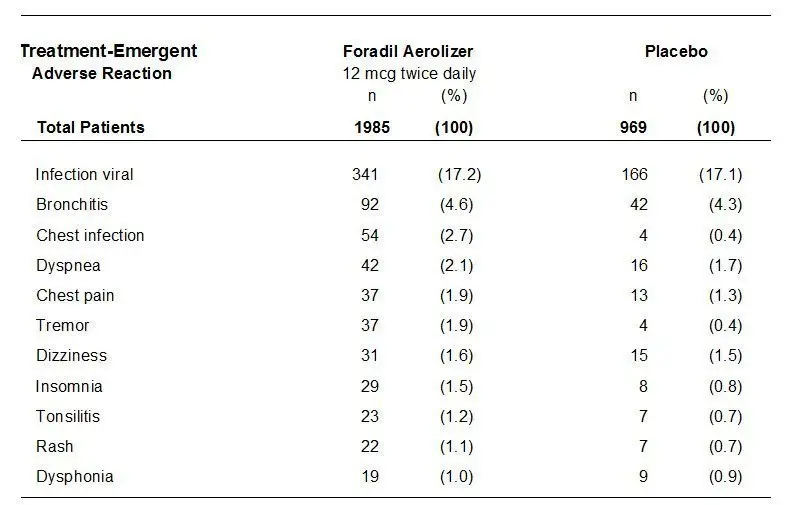
In patients 5-12 years of age, the numbers and percent of patients who reported treatment-emergent adverse reactions were comparable in the 12 mcg twice daily and placebo groups. In general, the pattern of the treatment-emergent adverse reactions observed in children differed from the usual pattern seen in adults. Treatment-emergent adverse reactions that were more frequent in the formoterol group than in the placebo group reflected infection/inflammation (viral infection, rhinitis, tonsillitis, gastroenteritis) or abdominal complaints (abdominal pain, nausea, dyspepsia).
Serious Asthma Exacerbations in Adolescents and Adults 12 Years of Age and Older
In two 12-week controlled trials with combined enrollment of 1095 patients 12 years of age and older, FORADIL AEROLIZER 12 mcg twice daily was compared to FORADIL AEROLIZER 24 mcg twice daily, albuterol 180 mcg four times daily, and placebo. Serious asthma exacerbations (acute worsening of asthma resulting in hospitalization) occurred more commonly with FORADIL AEROLIZER 24 mcg twice daily than with the recommended dose of FORADIL AEROLIZER 12 mcg twice daily, albuterol, or placebo. The results are shown in the following table.
| Foradil 12 mcg twice daily | Foradil 24 mcg twice daily | Albuterol 180 mcg four times daily | Placebo | |
| Trial #1 | ||||
| Serious asthma exacerbations | 0/136 (0) | 4/135 (3.0%)1 | 2/134 (1.5%) | 0/136 (0) |
| Trial #2 | ||||
| Serious asthma exacerbations | 1/139 (0.7%) | 5/136 (3.7%)2 | 0/138 (0) | 2/141 (1.4%) |
| 1 patient required intubation 2 patients had respiratory arrest; 1 of the patients died |
||||
In a 16-week, randomized, multi-center, double-blind, parallel-group trial, patients who received either 24 mcg twice daily or 12 mcg twice daily doses of FORADIL AEROLIZER experienced more serious asthma exacerbations than patients who received placebo [see Clinical Trials (14.1)]. The results are shown in the following table.
| Foradil 12 mcg twice daily | Foradil 24 mcg twice daily | Placebo | |
| Serious asthma exacerbations | 3/527 (0.6%) | 2/527 (0.4%) | 1/514 (0.2%) |
Serious Asthma Exacerbations in Children 5-11 Years of Age
The safety of FORADIL AEROLIZER 12 mcg twice daily compared to FORADIL AEROLIZER 24 mcg twice daily and placebo was investigated in one large, multicenter, randomized, double-blind, 52-week clinical trial in 518 children with asthma (ages 5-12 years) in need of daily bronchodilators and anti-inflammatory treatment. More children who received FORADIL AEROLIZER 24 mcg twice daily than children who received FORADIL AEROLIZER 12 mcg twice daily or placebo experienced serious asthma exacerbations, as shown in the next table.
| Foradil 12 mcg twice daily | Foradil 24 mcg twice daily | Placebo | |
| Serious asthma exacerbations | 8/171 (4.7%) | 11/171 (6.4%) | 0/176 (0) |
6.2 COPD
Of the 1634 patients in two pivotal multiple-dose Chronic Obstructive Pulmonary Disease (COPD) controlled trials, 405 were treated with FORADIL AEROLIZER 12 mcg twice daily. Treatment-emergent adverse reactions reported were similar to those seen in asthmatic patients, but with a higher incidence of COPD-related events in both placebo and formoterol treated patients.
The following table shows treatment-emergent adverse reactions where the frequency was greater than or equal to 1% in the FORADIL AEROLIZER group and where the rates in the FORADIL AEROLIZER group exceeded placebo. The two clinical trials included doses of 12 mcg and 24 mcg, administered twice daily. Seven treatment-emergent adverse reactions showed dose ordering among tested doses of 12 and 24 mcg administered twice daily; pharyngitis, fever, muscle cramps, increased sputum, dysphonia, myalgia, and tremor.
Number and Frequency of Treatment-Emergent Adverse Reactions in Adult COPD Patients Treated in Multiple-Dose Controlled Clinical Trials
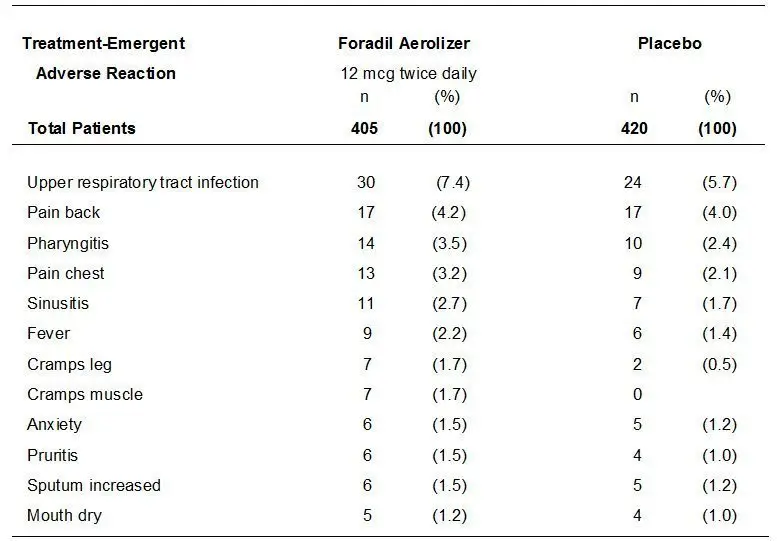
Overall, the frequency of all cardiovascular treatment-emergent adverse reactions in the two pivotal studies was 6.4% for FORADIL AEROLIZER 12 mcg twice daily, and 6.0% for placebo. There were no frequently-occurring specific cardiovascular treatment-emergent adverse reactions for FORADIL AEROLIZER (frequency greater than or equal to 1% and greater than placebo).
6.3 Postmarketing Experience
The following adverse reactions have been identified during post approval use of FORADIL. Because these reactions are reported voluntarily from a population of uncertain size, it is not always possible to reliably estimate their frequency or establish a causal relationship to drug exposure.
In extensive worldwide marketing experience with FORADIL, serious exacerbations of asthma, including some that have been fatal, have been reported. While most of these cases have been in patients with severe or acutely deteriorating asthma [see Warnings and Precautions (5.1, 5.2)], a few have occurred in patients with less severe asthma. It is not possible to determine from these individual case reports whether FORADIL AEROLIZER contributed to the events.
Immune system disorders: rare reports of anaphylactic reactions, including severe hypotension and angioedema
Metabolism and nutrition disorders: Hypokalemia, hyperglycemia
Respiratory, thoracic and mediastinal disorders: Cough
Skin and subcutaneous tissue disorders: Rash
Cardiac disorders: Angina pectoris, cardiac arrhythmias, e.g., atrial fibrillation, ventricular extrasystoles, tachyarrhythmia
Investigations: Electrocardiogram QT prolonged, blood pressure increased (including hypertension)
7. Drug Interactions
7.1 Adrenergic Drugs
If additional adrenergic drugs are to be administered by any route, they should be used with caution because the pharmacologically predictable sympathetic effects of formoterol may be potentiated.
7.2 Xanthine Derivatives or Systemic Corticosteroids
Concomitant treatment with xanthine derivatives or systemic corticosteroids may potentiate any hypokalemic effect of adrenergic agonists.
7.3 Diuretics
The ECG changes or hypokalemia that may result from the administration of non-potassium sparing diuretics (such as loop or thiazide diuretics) can be acutely worsened by beta-agonists, especially when the recommended dose of the beta-agonist is exceeded. Although the clinical significance of these effects is not known, caution is advised in the coadministration of beta-agonist with non-potassium sparing diuretics.
7.4 Monoamine Oxidase Inhibitors and Tricyclic Antidepressants, QTc Prolonging Drugs
Formoterol, as with other beta2-agonists, should be administered with extreme caution to patients being treated with monoamine oxidase inhibitors, tricyclic antidepressants, macrolides or drugs known to prolong the QTc interval because the action of adrenergic agonists on the cardiovascular system may be potentiated by these agents. Drugs that are known to prolong the QTc interval have an increased risk of ventricular arrhythmias.
7.5 Beta-blockers
Beta-adrenergic receptor antagonists (beta-blockers) and formoterol may inhibit the effect of each other when administered concurrently. Beta-blockers not only block the therapeutic effects of beta2-agonists, such as formoterol, but may produce severe bronchospasm in asthmatic patients. Therefore, patients with asthma should not normally be treated with beta-blockers. However, under certain circumstances, e.g., as prophylaxis after myocardial infarction, there may be no acceptable alternatives to the use of beta-blockers in patients with asthma. In this setting, cardioselective beta-blockers could be considered, although they should be administered with caution.
8. Use In Specific Populations
8.1 Pregnancy
Pregnancy Category C.
Teratogenic Effects: There are no adequate and well-controlled studies of FORADIL AEROLIZER in pregnant women. Animal reproduction studies of formoterol fumarate in rats and rabbits revealed evidence of teratogenicity as well as other developmental toxic effects. Because there are no adequate and well-controlled studies in pregnant women, FORADIL AEROLIZER should be used during pregnancy only if the potential benefit justifies the potential risk to the fetus.
Formoterol fumarate administered throughout organogenesis did not cause malformations in rats or rabbits following oral administration. When given to rats throughout organogenesis, oral doses equal to or greater than 80 times the maximum recommended human dose (MRHD) for adults (on a mcg/m2 basis for maternal doses of 0.2 mg/kg and above) delayed ossification of the fetus and doses equal to or greater than 2400 times the MRHD for adults (on a mcg/m2 basis for maternal doses of 6 mg/kg and above) decreased fetal weight. Formoterol fumarate has been shown to cause stillbirth and neonatal mortality at oral doses equal to or greater than 2400 times the MRHD for adults (on a mcg/m2 basis for maternal doses of 6 mg/kg and above) in rats receiving the drug during the late stage of pregnancy. These effects, however, were not produced at a dose equal to 80 times the MRHD for adults (on a mcg/m2 basis for a maternal dose of 0.2 mg/kg).
In another testing laboratory, formoterol fumarate was shown to be teratogenic in rats and rabbits. Umbilical hernia, a malformation, was observed in rat fetuses at oral doses equal to or greater than 1200 times the MRHD for adults (on a mcg/m2 basis for maternal doses of 3 mg/kg/day and above). Brachygnathia, a skeletal malformation, was observed for rat fetuses at an oral dose equal to 6100 times the MRHD for adults (on a mcg/m2 basis for a maternal dose of 15 mg/kg/day). In another study in rats, no teratogenic effects were seen at inhalation doses up to 500 times the MRHD for adults (on a mcg/m2 basis for maternal doses up to 1.2 mg/kg/day). Subcapsular cysts on the liver were observed for rabbit fetuses at an oral dose equal to 49000 times the MRHD for adults (on a mcg/m2 basis for a maternal dose of 60 mg/kg). No teratogenic effects were observed at oral doses up to 3000 times the MRHD for adults (on a mcg/m2 basis for maternal doses up to 3.5 mg/kg).
8.2 Labor and Delivery
There are no adequate and well-controlled human studies that have investigated the effects of FORADIL AEROLIZER during labor and delivery.
Because beta-agonists may potentially interfere with uterine contractility, FORADIL AEROLIZER should be used during labor only if the potential benefit justifies the potential risk.
Formoterol fumarate has been shown to cause stillbirth and neonatal mortality at oral doses equal to or greater than 2400 times the MRHD for adults (on a mcg/m2 basis for maternal doses of 6 mg/kg and above) in rats receiving the drug for several days at the end of pregnancy. These effects were not produced at a dose 80 times the MRHD for adults (on a mcg/m2 basis for a maternal dose of 0.2 mg/kg).
8.3 Nursing Mothers
In reproductive studies in rats, formoterol was excreted in the milk. It is not known whether formoterol is excreted in human milk, but because many drugs are excreted in human milk, caution should be exercised if FORADIL AEROLIZER is administered to nursing women. There are no well-controlled human studies of the use of FORADIL AEROLIZER in nursing mothers.
8.4 Pediatric Use
Asthma
Available data from controlled clinical trials suggest that LABA increase the risk of asthma-related hospitalization in pediatric and adolescent patients. For pediatric and adolescent patients with asthma who require addition of a LABA to an inhaled corticosteroid, a fixed-dose combination product containing both an inhaled corticosteroid and LABA should ordinarily be used to ensure adherence with both drugs [see Indications and Usage (1.1) and Warnings and Precautions (5.1)].
A total of 776 children 5 years of age and older with asthma were studied in three multiple-dose controlled clinical trials. Of the 512 children who received formoterol, 508 were 5-12 years of age, and approximately one third were 5-8 years of age [see Adverse Reactions (6.2, 6.3)].
Exercise-Induced Bronchospasm
A total of 25 pediatric patients, 4-11 years of age, were studied in two well-controlled single-dose clinical trials.
The safety and effectiveness of FORADIL AEROLIZER in pediatric patients below 5 years of age has not been established [see Clinical Trials (14.3), and Adverse Reaction (6.2)].
8.5 Geriatric Use
Of the total number of patients who received FORADIL AEROLIZER in adolescent and adult chronic dosing asthma clinical trials, 318 were 65 years of age or older and 39 were 75 years of age and older. Of the 811 patients who received FORADIL AEROLIZER in two pivotal multiple-dose controlled clinical studies in patients with COPD, 395 (48.7%) were 65 years of age or older while 62 (7.6%) were 75 years of age or older. No overall differences in safety or effectiveness were observed between these subjects and younger subjects. A slightly higher frequency of chest infection was reported in the 39 asthma patients 75 years of age and older, although a causal relationship with FORADIL has not been established. Other reported clinical experience has not identified differences in responses between the elderly and younger adult patients, but greater sensitivity of some older individuals cannot be ruled out.
10. Overdosage
The expected signs and symptoms with overdosage of FORADIL AEROLIZER are those of excessive beta-adrenergic stimulation and/or occurrence or exaggeration of any of the signs and symptoms listed under ADVERSE REACTIONS, e.g., angina, hypertension or hypotension, tachycardia, with rates up to 200 beats/min., arrhythmias, nervousness, headache, tremor, seizures, muscle cramps, dry mouth, palpitation, nausea, dizziness, fatigue, malaise, hypokalemia, hyperglycemia, and insomnia. Metabolic acidosis may also occur. Cardiac arrest and even death may be associated with an overdose of FORADIL AEROLIZER.
Treatment of overdosage consists of discontinuation of FORADIL AEROLIZER together with institution of appropriate symptomatic and/or supportive therapy. The judicious use of a cardioselective beta-receptor blocker may be considered, bearing in mind that such medication can produce bronchospasm. There is insufficient evidence to determine if dialysis is beneficial for overdosage of FORADIL AEROLIZER. Cardiac monitoring is recommended in cases of overdosage.
11. Foradil Description
FORADIL AEROLIZER consists of a dry powder formulation of formoterol fumarate intended for oral inhalation only with the AEROLIZER Inhaler. The inhalation powder is packaged in clear hard gelatin capsules.
Each capsule contains a dry powder blend of 12 mcg of formoterol fumarate and 25 mg of lactose (which contains trace levels of milk proteins) as a carrier.
The active component of FORADIL is formoterol fumarate, a racemate. Formoterol fumarate is a selective beta2-adrenergic agonist. Its chemical name is (±)-2-hydroxy-5-[(1RS)-1-hydroxy-2-[[(1RS)-2-(4-methoxyphenyl)-1-methylethyl]-amino]ethyl]formanilide fumarate dihydrate; its structural formula is:

Formoterol fumarate has a molecular weight of 840.9, and its empirical formula is (C19H24N2O4)2•C4H4O4•2H2O. Formoterol fumarate is a white to yellowish crystalline powder, which is freely soluble in glacial acetic acid, soluble in methanol, sparingly soluble in ethanol and isopropanol, slightly soluble in water, and practically insoluble in acetone, ethyl acetate, and diethyl ether.
The AEROLIZER Inhaler is a plastic device used for inhaling FORADIL. The amount of drug delivered to the lung will depend on patient factors, such as inspiratory flow rate and inspiratory time. Under standardized in vitro testing at a fixed flow rate of 60 L/min for 2 seconds, the AEROLIZER Inhaler delivered 10 mcg of formoterol fumarate from the mouthpiece. Peak inspiratory flow rates (PIFR) achievable through the AEROLIZER Inhaler were evaluated in 33 adult and adolescent patients and 32 pediatric patients with mild-to-moderate asthma. Mean PIFR was 117.82 L/min (range 34-188 L/min) for adult and adolescent patients, and 99.66 L/min (range 43-187 L/min) for pediatric patients. Approximately ninety percent of each population studied generated a PIFR through the device exceeding 60 L/min.
To use the delivery system, a FORADIL capsule is placed in the well of the AEROLIZER Inhaler, and the capsule is pierced by pressing and releasing the buttons on the side of the device. The formoterol fumarate formulation is dispersed into the air stream when the patient inhales rapidly and deeply through the mouthpiece.
12. Foradil - Clinical Pharmacology
12.1 Mechanism of Action
Formoterol fumarate is a long-acting beta2-adrenergic receptor agonist (beta2-agonist). Inhaled formoterol fumarate acts locally in the lung as a bronchodilator. In vitro studies have shown that formoterol has more than 200-fold greater agonist activity at beta2-receptors than at beta1-receptors. Although beta2-receptors are the predominant adrenergic receptors in bronchial smooth muscle and beta1-receptors are the predominant receptors in the heart, there are also beta2-receptors in the human heart comprising 10%-50% of the total beta-adrenergic receptors. The precise function of these receptors has not been established, but they raise the possibility that even highly selective beta2-agonists may have cardiac effects.
The pharmacologic effects of beta2-adrenoceptor agonist drugs, including formoterol, are at least in part attributable to stimulation of intracellular adenyl cyclase, the enzyme that catalyzes the conversion of adenosine triphosphate (ATP) to cyclic-3', 5'-adenosine monophosphate (cyclic AMP). Increased cyclic AMP levels cause relaxation of bronchial smooth muscle and inhibition of release of mediators of immediate hypersensitivity from cells, especially from mast cells.
In vitro tests show that formoterol is an inhibitor of the release of mast cell mediators, such as histamine and leukotrienes, from the human lung. Formoterol also inhibits histamine-induced plasma albumin extravasation in anesthetized guinea pigs and inhibits allergen-induced eosinophil influx in dogs with airway hyper-responsiveness. The relevance of these in vitro and animal findings to humans is unknown.
12.2 Pharmacodynamics
Systemic Safety and Pharmacokinetic/Pharmacodynamic Relationships
The major adverse effects of inhaled beta2-agonists occur as a result of excessive activation of the systemic beta-adrenergic receptors. The most common adverse effects in adults and adolescents include skeletal muscle tremor and cramps, insomnia, tachycardia, decreases in plasma potassium, and increases in plasma glucose.
Pharmacokinetic/pharmacodynamic (PK/PD) relationships between heart rate, ECG parameters, and serum potassium levels and the urinary excretion of formoterol were evaluated in 10 healthy male volunteers (25 to 45 years of age) following inhalation of single doses containing 12, 24, 48, or 96 mcg of formoterol fumarate. There was a linear relationship between urinary formoterol excretion and decreases in serum potassium, increases in plasma glucose, and increases in heart rate.
In a second study, PK/PD relationships between plasma formoterol levels and pulse rate, ECG parameters, and plasma potassium levels were evaluated in 12 healthy volunteers following inhalation of a single 120 mcg dose of formoterol fumarate (10 times the recommended clinical dose). Reductions of plasma potassium concentration were observed in all subjects. Maximum reductions from baseline ranged from 0.55 to 1.52 mmol/L with a median maximum reduction of 1.01 mmol/L. The formoterol plasma concentration was highly correlated with the reduction in plasma potassium concentration. Generally, the maximum effect on plasma potassium was noted 1 to 3 hours after peak formoterol plasma concentrations were achieved. A mean maximum increase of pulse rate of 26 bpm was observed 6 hours post dose. The maximum increase of mean corrected QT interval (QTc) was 25 msec when calculated using Bazett's correction and was 8 msec when calculated using Fridericia's correction. The QTc returned to baseline within 12-24 hours post-dose. Formoterol plasma concentrations were weakly correlated with pulse rate and increase of QTc duration. The effects on plasma potassium, pulse rate, and QTc interval are known pharmacological effects of this class of study drug and were not unexpected at the very high formoterol dose (120 mcg single dose, 10 times the recommended single dose) tested in this study. These effects were well-tolerated by the healthy volunteers.
The electrocardiographic and cardiovascular effects of FORADIL AEROLIZER were compared with those of albuterol and placebo in two pivotal 12-week double-blind studies of patients with asthma. A subset of patients underwent continuous electrocardiographic monitoring during three 24-hour periods. No important differences in ventricular or supraventricular ectopy between treatment groups were observed. In these two studies, the total number of patients with asthma exposed to any dose of FORADIL AEROLIZER who had continuous electrocardiographic monitoring was about 200.
Continuous electrocardiographic monitoring was performed in an 8-week, randomized, double-blind, and placebo controlled trial in 204 COPD patients treated with FORADIL AEROLIZER 12 mcg twice daily or placebo. Holter monitoring was used to evaluate predefined proarrhythmic events. Non-sustained ventricular tachycardia occurred in 2 (2.2%) of FORADIL AEROLIZER treated patients compared to none in the placebo group. An increase in ventricular premature beats (VPB) occurred in 3 (3.3 %) of FORADIL AEROLIZER treated patients compared to 2 (1.9%) in the placebo group. There were no events of sustained ventricular tachycardia, ventricular flutter or fibrillation, or symptomatic runs of VPB. One patient in the FORADIL AEROLIZER group had a serious adverse event of atrial flutter.
The electrocardiographic effects of FORADIL AEROLIZER were evaluated versus placebo in a 12-month pivotal double-blind study of patients with COPD. An analysis of ECG intervals was performed for patients who participated at study sites in the United States, including 46 patients treated with FORADIL AEROLIZER 12 mcg twice daily, and 50 patients treated with FORADIL AEROLIZER 24 mcg twice daily. ECGs were performed predose, and at 5-15 minutes and 2 hours post-dose at study baseline and after 3, 6, and 12 months of treatment. The results showed that there was no clinically meaningful acute or chronic effect on ECG intervals, including QTc, resulting from treatment with FORADIL AEROLIZER.
Tachyphylaxis/Tolerance
In a clinical study in 19 adult patients with mild asthma, the bronchoprotective effect of formoterol, as assessed by methacholine challenge, was studied following an initial dose of 24 mcg (twice the recommended dose) and after 2 weeks of 24 mcg twice daily. Tolerance to the bronchoprotective effects of formoterol was observed as evidenced by a diminished bronchoprotective effect on FEV1 after 2 weeks of dosing, with loss of protection at the end of the 12 hour dosing period.
Rebound bronchial hyper-responsiveness after cessation of chronic formoterol therapy has not been observed.
In three large clinical trials in patients with asthma, while efficacy of formoterol versus placebo was maintained, a slightly reduced bronchodilatory response (as measured by 12-hour FEV1 AUC) was observed within the formoterol arms over time, particularly with the 24 mcg twice daily dose (twice the daily recommended dose). A similarly reduced FEV1 AUC over time was also noted in the albuterol treatment arms (180 mcg four times daily by metered-dose inhaler).
12.3 Pharmacokinetics
Information on the pharmacokinetics of formoterol in plasma has been obtained in healthy subjects by oral inhalation of doses higher than the recommended range and in Chronic Obstructive Pulmonary Disease (COPD) patients after oral inhalation of doses at and above the therapeutic dose. Urinary excretion of unchanged formoterol was used as an indirect measure of systemic exposure. Plasma drug disposition data parallel urinary excretion, and the elimination half-lives calculated for urine and plasma are similar.
Absorption
Following inhalation of a single 120 mcg dose of formoterol fumarate by 12 healthy subjects, formoterol was rapidly absorbed into plasma, reaching a maximum drug concentration of 92 pg/mL within 5 minutes of dosing. In COPD patients treated for 12 weeks with formoterol fumarate 12 or 24 mcg twice daily, the mean plasma concentrations of formoterol obtained at 10 min, 2 h, and 6 h post inhalation ranged between 4.0 and 8.8 pg/mL and 8.0 and 17.3 pg/mL, respectively.
Following inhalation of 12 to 96 mcg of formoterol fumarate by 10 healthy males, urinary excretion of both (R,R)- and (S,S)-enantiomers of formoterol increased proportionally to the dose. Thus, absorption of formoterol following inhalation appeared linear over the dose range studied.
In a study in patients with asthma, when formoterol 12 or 24 mcg twice daily was given by oral inhalation for 4 weeks or 12 weeks, the accumulation index, based on the urinary excretion of unchanged formoterol ranged from 1.63 to 2.08 in comparison with the first dose. For COPD patients, when formoterol 12 or 24 mcg twice daily was given by oral inhalation for 12 weeks, the accumulation index, based on the urinary excretion of unchanged formoterol was 1.19 - 1.38. This suggests some accumulation of formoterol in plasma with multiple dosing. The excreted amounts of formoterol at steady-state were close to those predicted based on single-dose kinetics. As with many drug products for oral inhalation, it is likely that the majority of the inhaled formoterol fumarate delivered is swallowed and then absorbed from the gastrointestinal tract.
Distribution
The binding of formoterol to human plasma proteins in vitro was 61%-64% at concentrations from 0.1 to 100 ng/mL. Binding to human serum albumin in vitro was 31%-38% over a range of 5 to 500 ng/mL. The concentrations of formoterol used to assess the plasma protein binding were higher than those achieved in plasma following inhalation of a single 120 mcg dose.
Metabolism
Formoterol is metabolized primarily by direct glucuronidation at either the phenolic or aliphatic hydroxyl group and O-demethylation followed by glucuronide conjugation at either phenolic hydroxyl groups. Minor pathways involve sulfate conjugation of formoterol and deformylation followed by sulfate conjugation. The most prominent pathway involves direct conjugation at the phenolic hydroxyl group. The second major pathway involves O-demethylation followed by conjugation at the phenolic 2'-hydroxyl group. Four cytochrome P450 isozymes (CYP2D6, CYP2C19, CYP2C9, and CYP2A6) are involved in the O-demethylation of formoterol. Formoterol did not inhibit CYP450 enzymes at therapeutically relevant concentrations. Some patients may be deficient in CYP2D6 or 2C19 or both. Whether a deficiency in one or both of these isozymes results in elevated systemic exposure to formoterol or systemic adverse effects has not been adequately explored.
Excretion
Following oral administration of 80 mcg of radiolabeled formoterol fumarate to 2 healthy subjects, 59%-62% of the radioactivity was eliminated in the urine and 32%-34% in the feces over a period of 104 hours. Renal clearance of formoterol from blood in these subjects was about 150 mL/min. Following inhalation of a 12 mcg or 24 mcg dose by 16 patients with asthma, about 10% and 15%-18% of the total dose was excreted in the urine as unchanged formoterol and direct conjugates of formoterol, respectively. Following inhalation of 12 mcg or 24 mcg dose by 18 patients with COPD the corresponding values were 7% and 6-9% of the dose, respectively.
Based on plasma concentrations measured following inhalation of a single 120 mcg dose by 12 healthy subjects, the mean terminal elimination half-life was determined to be 10 hours. From urinary excretion rates measured in these subjects, the mean terminal elimination half-lives for the (R,R)- and (S,S)-enantiomers were determined to be 13.9 and 12.3 hours, respectively. The (R,R)- and (S,S)-enantiomers represented about 40% and 60% of unchanged drug excreted in the urine, respectively, following single inhaled doses between 12 and 120 mcg in healthy volunteers and single and repeated doses of 12 and 24 mcg in patients with asthma. Thus, the relative proportion of the two enantiomers remained constant over the dose range studied and there was no evidence of relative accumulation of one enantiomer over the other after repeated dosing.
Special Populations
Gender: After correction for body weight, formoterol pharmacokinetics did not differ significantly between males and females.
Geriatric and Pediatric: The pharmacokinetics of formoterol have not been studied in the elderly population, and limited data are available in pediatric patients.
In a study of children with asthma who were 5 to 12 years of age, when formoterol fumarate 12 or 24 mcg was given twice daily by oral inhalation for 12 weeks, the accumulation index ranged from 1.18 to 1.84 based on urinary excretion of unchanged formoterol. Hence, the accumulation in children did not exceed that in adults, where the accumulation index ranged from 1.63 to 2.08 (see above). Approximately 6% and 6.5% to 9% of the dose was recovered in the urine of the children as unchanged and conjugated formoterol, respectively.
Hepatic/Renal Impairment
The pharmacokinetics of formoterol have not been studied in subjects with hepatic or renal impairment.
| FORADIL
formoterol fumarate capsule |
||||||||||||||||||||
|
||||||||||||||||||||
|
||||||||||||||||||||
|
||||||||||||||||||||
|
||||||||||||||||||||
|
||||||||||||||||||||
|
||||||||||||||||||||
| FORADIL
formoterol fumarate capsule |
||||||||||||||||||
|
||||||||||||||||||
|
||||||||||||||||||
|
||||||||||||||||||
|
||||||||||||||||||
|
||||||||||||||||||
|
||||||||||||||||||
| Labeler - Merck Sharp & Dohme Corp. (001317601) |
| Registrant - Novartis Pharmaceuticals Corporation (002147023) |




